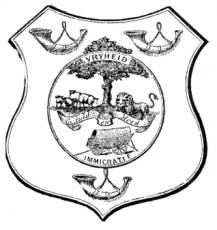Orange Free State (OFS) didn’t
get its name because oranges grow there, although there they do grow in great
profusion. Nor did the Orange River get its name because of its muddy,
orange-colored flow, although orange it is for much of its westward 1511-mile
course across South Africa, from Lesotho’s mountains to the Atlantic. Even a
fish species is named after its mud.
Moreover, the triangular topiary orange tree design
that appears on all Orange Free State stamps doesn’t look anything like
the orange trees that grew in Orange Free State. And, contrary to what some
stamp experts and many collectors think, the three horns dropping from the
orange tree are not post horns.
Why the seeming deception? The explanation is
straightforward.
In fact, the image on these stamps isn’t meant to
depict anything African at all. It’s a thoroughly European design.
Robert Jacob Gordon, a Dutch explorer and nature
artist, named the river “Orange” in 1799 after the Dutch House of Orange, a
European dynasty that traces its lineage to the medieval principality of Orange
in Provence, southern France. Later, the river lent its colorful name to the
government formed in 1836 by the Trekboers (Afrikaners,
staunch Calvinists farmers – Dutch, French, German). In 1824, Trekboers arrived
in what became Orange Free State (OFS) from Cape Colony in search of
pastureland for their cattle. The Boers’ subsequent “Great Trek” increased
their numbers rapidly.
By 1854 the Boers were bold enough to ask King William III of The Netherlands
to give them a proper coat of arms and a flag, even though OFS was not a Dutch
colony. The King complied and, being of the House of Orange, he bequeathed them
the heraldry of that heritage. The stamps’ orange topiary is reminiscent of the
carefully coiffured shrubbery that European royalty grew in their glass-enclosed
orangeries. The three “buglehorns” come from an old House of Orange emblem and
have no association with mail delivery.
Delighted with their fanciful coat of arms, the Boers
garnished their stamps, coins, magazines and documents with all or parts of the
design, especially the orange tree with a pruned lower branch. I suppose it
helped legitimize their defiant existence in remote Africa.
A variation was used as a hand-stamped precancel on
postcard stamps.
By the end of the 19th Century, what had
started out as friendly relations between the British and the Boers turned sour
and the 2nd Boer War ensued. The British ultimately won by using a brutal
scorched earth strategy. As a result, OFS was renamed Orange River Colony (ORC)
in 1900 and “V.R.I” (Victoria Regina et Imperatrix) was overprinted on
remaining supplies of OFS stamps.
When these ran out, overprinted Cape of Good Hope stamps
were placed in service. Then, after the Peace Treaty of Vereeniging was signed
in 1902, standard British colony designs were issued featuring the crowned
Edwardian profile flanked by African animals, a gnu and a tommie (Thompson
gazelle).
South
Africa stamps were used after the colony became the Orange Free State Province
within the Union of South Africa, 1910. As a tribute to Trekboers, though, South
Africa continued issuing orange topiary stamps until the 1950s. Half of them
have the Afrikaans inscription “Suidafrika” at the top; all have a nipped off
lower branch, as on the original House of Orange emblem. Anomalies and variations
sprouted like orange tree buds.
After South
Africa’s state-enforced apartheid was dismantled (1993-94), the province was
renamed Free State, dropping its imaginary connections with the House of
Orange. Orange River
retains its original name - and its orange color, too, thanks to diamond prospecting, farming,
and elephant wallowing.
Census: 31 in BB spaces, 12 on supplement page.
(1) Map Credit: Keenan
Pepper - Own work, CC BY-SA 4.0,
https://commons.wikimedia.org/w/index.php?curid=66101365
(2) Photo credit: OFS Archives.
(3) Photo credit: https://www.ngccoin.com/price-guide/world/south-africa-orange-free-state-penny-x-pn1-1874-cuid-1101652-duid-1559932
(4) Map salvaged from Gerben Van Gelder’s now sadly
defunct "Stamp World History" web site.
(5) Photo credit: https://paracaddis.wordpress.com/tag/orange-river-mudfish/


















A terrific post. I don't collect this area, but I always appreciate the fruits of your great research!
ReplyDeleteRoy
Thanks, Roy. I'm please that you enjoy the posts.
ReplyDeleteThanks, Roy. I enjoy writing the posts.
ReplyDelete